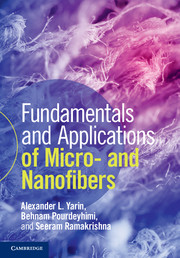Book contents
- Frontmatter
- Contents
- Preface
- 1 Introduction
- 2 Polymer physics and rheology
- 3 General quasi-one-dimensional equations of dynamics of free liquid jets, capillary and bending instability
- 4 Melt- and solution blowing
- 5 Electrospinning of micro- and nanofibers
- 6 Additional methods and materials used to form micro- and nanofibers
- 7 Tensile properties of micro- and nanofibers
- 8 Post-processing
- 9 Applications of micro- and nanofibers
- 10 Military applications of micro- and nanofibers
- 11 Applications of micro- and nanofibers, and micro- and nanoparticles: healthcare, nutrition, drug delivery and personal care
- Subject Index
- References
10 - Military applications of micro- and nanofibers
Published online by Cambridge University Press: 05 June 2014
- Frontmatter
- Contents
- Preface
- 1 Introduction
- 2 Polymer physics and rheology
- 3 General quasi-one-dimensional equations of dynamics of free liquid jets, capillary and bending instability
- 4 Melt- and solution blowing
- 5 Electrospinning of micro- and nanofibers
- 6 Additional methods and materials used to form micro- and nanofibers
- 7 Tensile properties of micro- and nanofibers
- 8 Post-processing
- 9 Applications of micro- and nanofibers
- 10 Military applications of micro- and nanofibers
- 11 Applications of micro- and nanofibers, and micro- and nanoparticles: healthcare, nutrition, drug delivery and personal care
- Subject Index
- References
Summary
Chemical warfare differs from conventional warfare, such as explosives, in the sense that the toxicity of the chemicals used is very dangerous to the combatants in the battlefield, or to the civil population being affected during a war or as a result of a terrorist attack. The threat is amplified by concealment and low cost and relatively easy production of these agents, which renders them weapons of mass destruction. It becomes essential in such a situation that soldiers wear protective clothing, respirators, face masks, gloves, etc. Initially German troops unleashed chemical warfare agents, such as mustard agent, HD, during World War I in 1915, and this resulted in much more concern during World War II. Thus research on decontamination of chemical and biological warfare agents (CWAs) has been the subject of serious interest in many research laboratories since World War II. Mustard gas or bis(2-chloroethyl) sulfide is one of the highly cytotoxic, readily methylating CWAs that are regulated under the 1993 Chemical Weapons Convention (CWC). It covalently binds to DNA bases or forms disulfide bonds with the thiol groups. This readily leads to programmed cell death or the mutated DNA leads to cancer. The simultaneous danger associated with this toxic agent is its high skin penetration owing to its high lipophilicity, which results in immediate blister formation and huge uptake through skin within a short duration of exposure (Ivarsson et al. 1992).
Conventional modes of decontamination involve activated charcoal or other such heavy physical adsorbants of the contaminant. When compared with technologies employing conventional catalysts and reactive sorbents, which are specific and sometimes time-consuming, nanotechnology-based nanomaterials are highly reactive, nonselective and multifunctional in character. Current development of nanoparticles such as MgO, Al2O3, Fe2O3, ZnO and TiO2 and their incorporation into nanofibers impart enhanced catalytic, disinfection and sensing capabilities, photo-protection capability, and stain-resistance and self-cleaning properties. The testing of these materials in textiles and protective clothing against CWAs showed that they have potential as replacement technology in such applications.
- Type
- Chapter
- Information
- Fundamentals and Applications of Micro- and Nanofibers , pp. 359 - 379Publisher: Cambridge University PressPrint publication year: 2014
References
- 1
- Cited by



